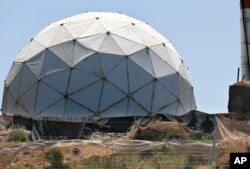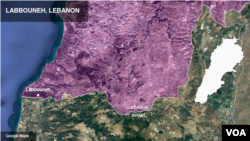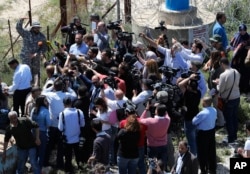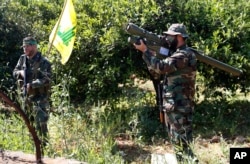With their Kalashnikovs and anti-aircraft missiles pointing outward, the Hezbollah militants peered at journalists from an orange grove in a village on the Israeli border.
"No photos!" a Hezbollah official ordered after almost all had taken pictures of the unusual peacetime scene.
Thursday's odd encounter was part of a south Lebanon media tour that Hezbollah organized. The objective was to highlight Israeli defensive measures taken in the past year along the southern frontier.
The choreographed outing also was meant to send a message to Israel: Hezbollah is here and ready in case of a war.
The tour was the first since an inconclusive month-long war with Israel in 2006. It came amid heightened tensions along the border, with each side promising to inflict massive casualties on the other in any conflict.
In the past month, Israel has unveiled a plan to evacuate up to a quarter-million civilians from border communities in case of attacks from Hezbollah or other Islamic militant groups. It held a drill at a base in northern Israel simulating a Lebanese village and an urban warfare environment that Israeli troops struggled with in 2006.
Israel has also built up its missile defenses. This month, it unveiled a joint U.S.-Israeli interceptor to counter Hezbollah's medium-range rockets.
Willing to fight
Hezbollah chief Hassan Nasrallah has said the group is not seeking a resumption of hostilities, but he vowed that if war did begin, his forces would strike Israel's Dimona nuclear facilities. Hezbollah officials also have signaled that the next war will involve fighters infiltrating Israel's northern settlements.
At the border Thursday, Hezbollah officials were keen to point out it is Israel that is preparing for war, showing journalists a series of fortifications the Israelis have made against anticipated Hezbollah infiltration — huge concrete blocks, barbed and electrified fences, deep trenches.
Standing at the border in Labbouneh, a Hezbollah officer said the measures highlight the changes in Israel's calculations.
"For the first time in this enemy's history, it is switching from an offensive to a defensive doctrine," the man who identified himself as "Ehab" told journalists.
The Labbouneh site was one of three border points visited Thursday on the U.N.-drawn "Blue Line," including a point across from a large Israeli surveillance post and radar at Jal al-Alam.
The tour, under the gaze of U.N peacekeepers based in the border town of Naqoura, sometimes took on a theatrical nature. At one point, as journalists walked near an Israeli surveillance post, two Italian U.N. peacekeepers came running up the hill, shouting for the group to stop taking photos — apparently surprised that such a large group was so close to the frontier.
The Lebanese-Israeli frontier has been mostly quiet since the 2006 war, which broke out after the Iranian-backed militant group's guerrillas crossed into Israel and captured two Israeli soldiers. The ensuing conflict killed about 1,200 Lebanese, most of them civilians, and 160 Israelis.
The war ended with a U.N. resolution that created a buffer zone, which was supposed to be free of Hezbollah militants.
Violations unsurprising
Brigadier General Ram Yavne, head of the Israeli military's strategic division, said the latest show of arms was "more blunt" than usual, but violations of the U.N. resolution are nothing new.
He said the border tour was primarily a message of "mutual deterrence" with Israel, and that while Israel takes the threat seriously, Thursday's show of force would not change the overall "calculus."
"I don't think this organization is in a very comfortable situation these days," he said. "Its leadership absolutely understands the cost of an escalation."
Israeli officials say Hezbollah has significantly upgraded its capabilities with a larger, more sophisticated arsenal since the 2006 war. While largely staying out of the Syrian civil war, the Israeli military has carried out a number of airstrikes against suspected arms shipments thought to be headed to Hezbollah.
Hezbollah, which has lost more than 1,000 of its fighters in the Syrian war, clearly has no appetite for a fight. But Salem Zahran, a Hezbollah-aligned analyst on the tour, said another war between the two was inevitable and was tied to the Syrian conflict, where there have been flare-ups with Israel in the Golan area south of Damascus.
The next war will not take place only on Lebanese territory, but also in Syria and "inside occupied Palestine," Zahran said.
He said Hezbollah wanted to send a message through the tour, in case Israel was preparing for war. "The message is: I see you, and I have another scenario for you."















